Air Combat
Manoeuvres continued Part 3
Introduction: (Author Gutter from JG52)
The Staffel......maximum pwnage. A staffel by default
consists of three schwarme (2 minimum, 4 maximum) acting in concert to
achieve the ultimate goal of dominance in a specified sector of the front.
To achieve this feat and to avoid winding up in a careless free for all, all
pilots involved really need to step it up a notch. I can't stress that
enough. The more planes & pilots you add into the mix, the harder it is to
coordinate and the more likely people start dying due to carelessness. In
reality, it's not all that hard if everyone is working with the same game
plan. In a nutshell... Everything you've read about the rotte and schwarme
up to this point still applies, the difference is in the execution of
everything. Comms, formations, and teamwork go to new heights when operating
as a staffel... and tactics to completely shut down an area (as opposed to
being a nuisance) start to become a reality.
Pre-Flight:
Staffel Lead:-
Flying as a staffel takes a bit of
prep work. During the form up, flight assignments will be given out.
This is handled by the ranking officer online. i.e.. If it's Gruppe I's
time zone.. the Gruppe I. Commander is the head guy for this mission. If
he is not present... it goes to his Adjutant, after him it's completely
rank based... although anyone (including the Commander) can choose to
pass it down if they don't feel like leading that sortie.
Assignment considerations:-
Flight assignments should always be
given in a manner that will balance the experience throughout the
staffel. i.e.. Don't put all your experienced pilots in one schwarme,
and leave the others vulnerable. Put your most experienced pilots as
flight leads, and then the next most experienced as section leads.
Leadership abilities should also be considered when issuing lead
positions. It's a balancing act. Though it must be stated, that you
shouldn't always have the same guys leading day in and day out. Other
pilots should have chances to gain some experience in that role as well.
Issuing Flight Assignments:-
Note: The individual schwarme of the
staffel will be designated as Red, Yellow, Green, & Blue (1, 2, 3,
4) for organization & communication purposes. This becomes more
important in comms (discussed later), but i state it now because its
relevant.
As lead of the staffel, you should always
hand out assignments in the same manner. You state the flight (Red,
Yellow, Green, etc. etc.) and then the four pilots who will make up that
flight. The first pilot named is the flight lead, the second pilot named
is his wingman, the 3rd is the section lead, and the 4th is the section
leads wingman.
Example:
"Yellow flight is Whoofe, Fish, Raus &
Stalski....... Green flight is Zacast, Chief, Fridge & Hahn".
Whoofe(1) is Yellow lead with Fish(2) as his wingman.
Raus(3) is lead of second Element with Stalski(4) as his wingman. The
numbers i placed there correspond to the position in formation images I
show later. Same applies to the Green flight. Basically just keep it
consistent to make it less confusing for pilots. If we always do it the
someway.. no one should ever have any problems with what role they are
supposed to take up.
Flight leads are an important part of the staffel.
They are the voice of reason to the pilots they are leading, and are the
channel through which the stafflels tasks get carried out. They should
always be focused on the bigger picture, and should rally their pilots
if they start becoming over aggressive and risk compromising the
integrity of their flight & the staffel as a whole. The other flights
are counting on you to do your job and not put undue risk to yourself.
If your flight is BARCAP'ing for the other flights.. you need to make
sure you keep in a position to be effective in your role. As soon as you
get too tied up, whether it be deck furballing or running down
enemies.... the other flights could be in jeopardy because the BARCAP is
no longer there. Just keep that in mind.. it's a team effort. And it's
your job as flight lead, to make sure everything is running as it
should.
Communication:
Obviously, with 3 to 4 schwarme (12 - 16 pilots)
coordinating in supporting roles.... comms are going to break down when
the shit hits the fan. To combat that, we are going to use some callsign
codes & some advanced teamspeak channel features.
Teamspeak:-
If you haven't noticed by now... in our teamspeak
sever under "Operations".. their are four rooms. Labelled with Red,
Yellow, Green & Blue. This is not something i just decided to add on a
whim. They've been there since the TS server went up a year and a half
ago for just this purpose. If you haven't already, assign hotkeys to
jump between those channels. Ctrl-Z, X, C, & V works well if you can't
decide. Also, assign a hotkey to jump to the Operations main channel.
The staffel will congregate in the Operations main
channel at form up for flight assignments and general mission overview.
Once they have their flight assignments etc. they will jump to their
designated TS channel. Communication between flights & other pilots will
still be possible by a second 'global' transmit key being mapped. To do
this, open up Settings->Key Settings
from the TS menu. and Adding
a new binding. Select the hotkey for that bind, and choose
Whisper to->Channel pre-defs->Channel Family
in the "action" section of that same dialog. Hotkeys for channel jumps
discussed in the previous paragraph are set from this same dialog box
under the "Switch To" action. Just make sure you set different hotkeys
for each jump.
You should now have TWO transmit keys. A normal one..
that will allow you to transmit to pilots in the same channel as you.
And a global one that will allow you to transmit to all pilots under the
"Operations" channel, even if they are in a flight specific sub-channel.
This global channel is for coordinating the flights and for emergency
transmissions, and should be used less frequently than the regular
channel transmit key to avoid interrupting people that may be talking
amongst themselves in their respective channels. The Global channel can
be used freely on long ingresses to target, but once near target.. comms
on this channel are on a need to know basis.
*takes breath*
Transmitting:-
Since we've got pilots separated in TS, knowing who is
talking and where its coming from is going to be very important. To
address this, pilots will take on call signs derived from the colour
code of the schwarme they are in and the position in that schwarme they
are assuming. I.e. The lead of red flight is "Red 1" (or "Red Leader).
The section lead of yellow flight is "Yellow 3" etc. etc.
Not only does this instantly let you know which TS
channel this transmission is coming from, but it lets you know where in
relation to the world around you the transmission is coming from also,
and how you should react to it.
example:
Red flight sets up a patrol on the Eastern
side of the target area, while Yellow flight is patrolling the
Western Side. After ten minutes this call comes over the global TS
channel out of nowhere:
"This is Red-Four I got EA all over me!"
Instantly these things happen:
1. The Pilot in the Red-Three position knows
that his wingman (who should be close by) is in trouble and that he
may be in danger himself.
2. Red-One & Two know that their second
element (who shouldn't be far off) is in trouble and to start
immediately looking around in their close vicinity for the threats.
3. Yellow flight is alerted to the situation
and knows exactly where to start heading for support.
All this is communicated in one call, without having
to remember voices.. or which voice is in which flight, or if this
transmission came from your channel or the global channel... or even
which position in that flight that voice is coming from. It's allot
better than Stalski saying "I got EA all over me!". That would lead to
confusion. Which flight is he in? Where are they operating? Who's his
wingman? Do i even know what stalski's voice sounds like? OMG I NEED A
HUG!!!
You get the idea. Comms are important.. we all know
that. But when operating in a staffel, comms become critical.
Note: when transmitting on the global channel about
being engaged or to relay your flights status to others... it's probably
a good idea to use "Engaged Offensive, Engaged Defensive, or All clear"
in your transmission.
Examples:
Red Lead
(to global) - "Green, what's your status".
Green Lead (to global) -"Green Leader, All clear".
Yellow 2
(to yellow) - "EA diving on us!!!" <- note: no callsign in
the xmit..... in emergencies don't think, just talk!"
Yellow Lead (to global) - "This is yellow, Engaged
defensive, NW town.... 2.5".
Blue Lead (to global) - "Copy yellow, blue is on
the way".
Green Lead
(to global) - "This is green, Engaged offensive, S town... 4k".
Red Lead (to global) - "Copy green, Red otw for
support".
Red Lead (to red) - "red 3, go element abreast".
So now you know how to organize the mission,
how to break into flights, xmit across channels with clarity and ease.. etc
etc. All the Basics! Let's keep moving shall we?
Formation Flying:
I won't spend much time on this, because by
now you should all know the basic formations we use. If you need a refresher
(recommended), see the schwarme and rotte pages. The formation of the
staffel is completely up to the staffel lead (Red Leader). When forming as a
staffel however, the schwarme themselves should be separate, easily
discoverable parts of the formation. You don't want to be a giant mass of
fighters, it makes it hard to see who is with who and completely pork's
coordinated heading changes. If there's 3 schwarme flying in Line
Abreast.....the 3 schwarme should EACH be in either a tight Finger Four or a
tight Echelon. When you look off your wing at another schwarme in line
abreast, you should see a tight formation off your wing some distance away
and they should be easily distinguishable from the aircraft in your own
formation. So basically what I'm saying is CLOSE THOSE FORMATIONS UP. When
flying as a staffel formation.. we don't need each scharme in a loose
"combat spread", they each need to be closed up so that staffel formation
turns are quick and can be executed without it falling apart. Here are some
examples off staffel formations:
Note: in the following
pics, schwarme can be either a Finger Four or Echelon... and is
specified by the flight lead. If a schwarme is isolated due to combat
action... or just due to the layout of the formation type itself... it
should be in it's own defensive lookout formation such as line or
element abreast without regard to the rest of the staffel.
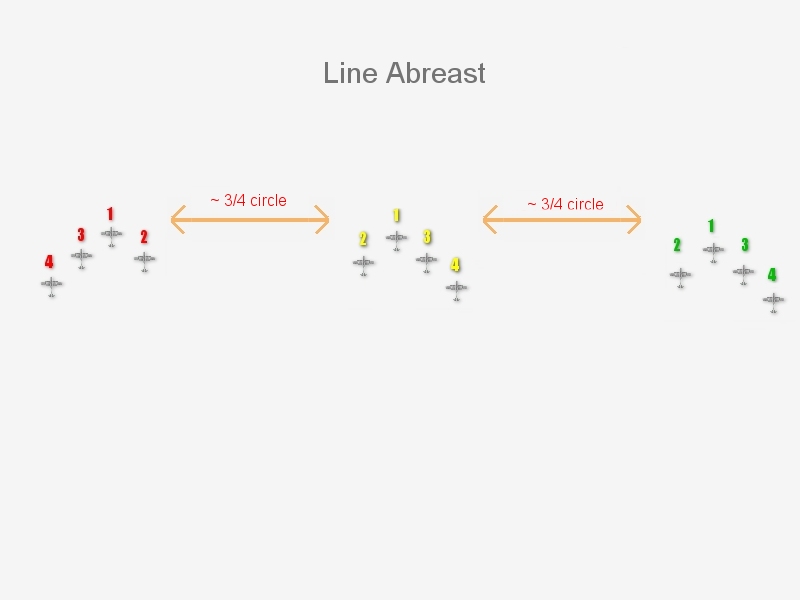
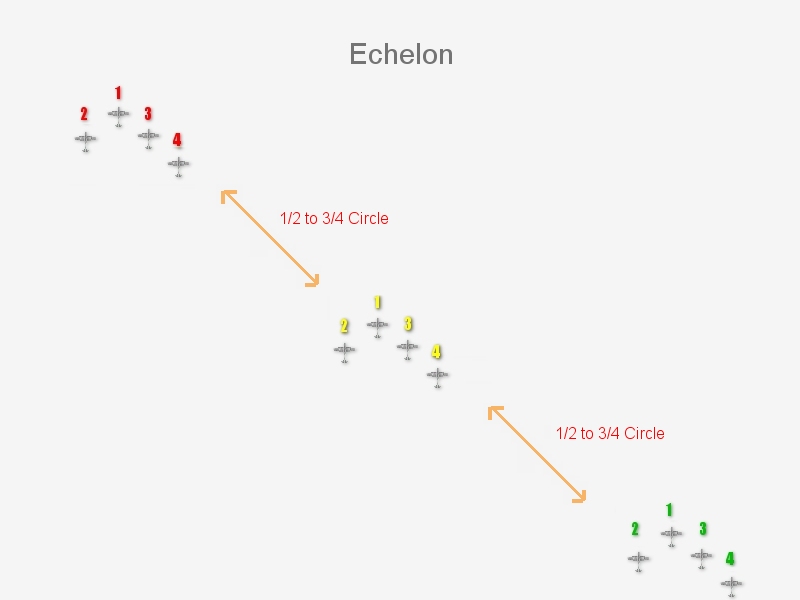
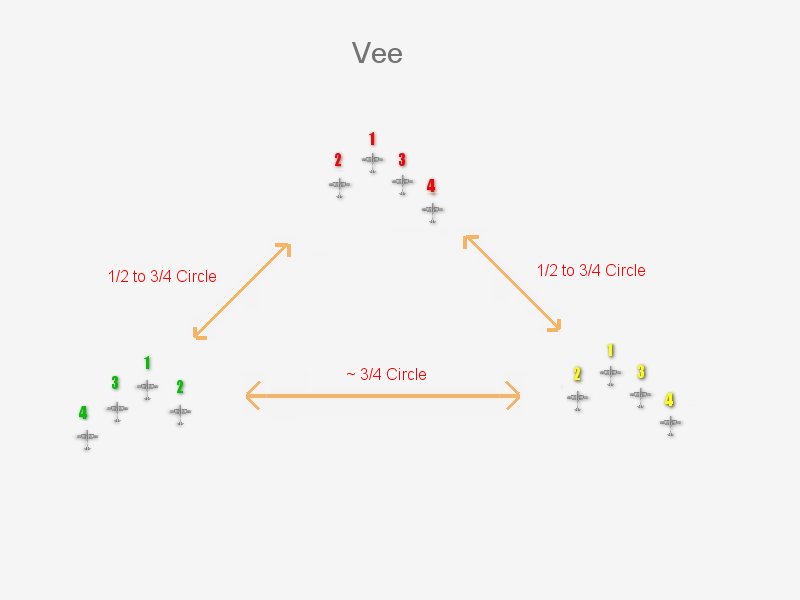

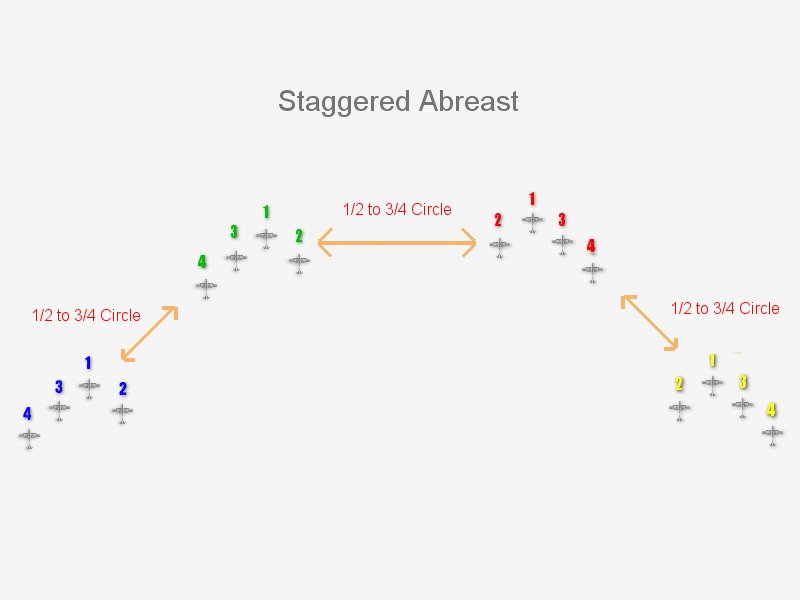
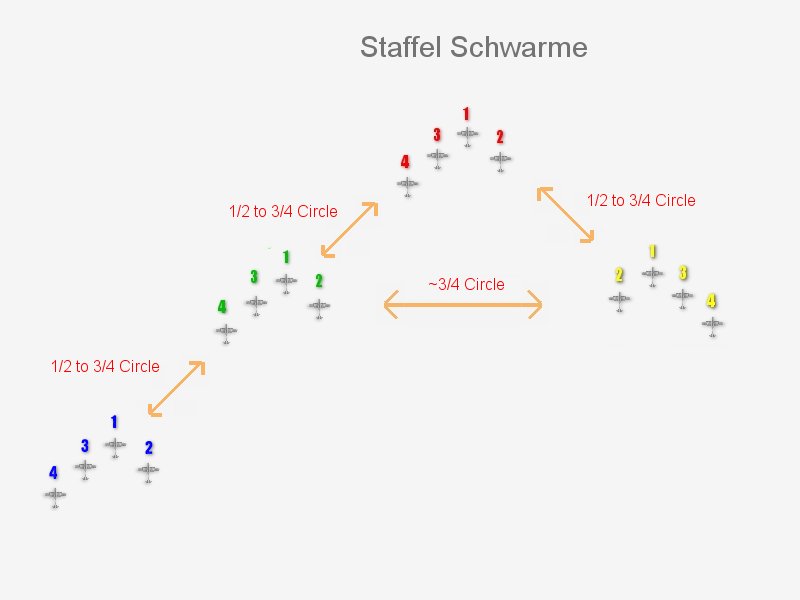
For a three schwarme staffel, my picks for most used would
be the Section & Stinger, and Full line abreast. For four schwarme staffels...
the staggered abreast would probably be most used. Or maybe have 3 out front
in line abreast with the forth as a stinger. Note, the Circle ranges stated
above are just recommendations, and are most likely going to be slightly
further apart in practice to keep flights out of each others hair.
As was stated above, if a schwarme is apart from the
staffel formation (due to combat or the nature of the staffel formation)...
standard schwarme formation types are used for it instead of tight finger
four or echelon formations. For instance, if Yellow flight splits from the
staffel formation upon arrival at the objective to do its own assigned
task... yellow flight breaks it's tight formation and assumes a more "combat
spread" schwarme formation (see schwarme tactics). Another example would be
if Green flight is assigned a high six stinger position on the formation..
it would fly in a more abreast type formation for lookout coverage.
Formation flying is half the fun of being in a squad. At
least to me. When you see a good formation, it gives you goose bumps. And
any enemy who stumbles into an intimidating staffel formation like the ones
above... is going to shat themselves. Imagine being in a random gaggle of
spitfires, and approaching from the distance is 3 tight beautiful Finger
Four formations of 109's arranged in a wide line-abreast. The schwarme on
the ends kick out to bracket you guys and the one in the middle menacingly
drives right on in to you. Would you not totally shit yourself? You would
think "Oh ... Meh ... God... These.. guys must be pro's... I gotta get the
fark outta here!".
Staffel Tactics & Combat
Rotte & Schwarme tactics were mainly involved in the
details of actual combat & survival. i.e.. how to execute a fight & stay
alive. Staffel tactics is more of an abstraction that is laid over those
two. It deals more with coordination and high-level group tactics for
controlling airspace, and is the final step to the whole "Domination Through
Teamwork" motto. There are no hard rules here. It is up to the Staffel
leader to decide best how to use his available forces. He should survey the
air situation, and devise a plan that will achieve the desired outcome.
Examples:
Say that the area of airspace contention is the zundert/roos/wuustwezel
area. We want control of the airspace there. Upon arriving there, EA is
extremely light. Staffel lead decides to keep enemy aircraft from ever
reaching it. This would be the gameplan.
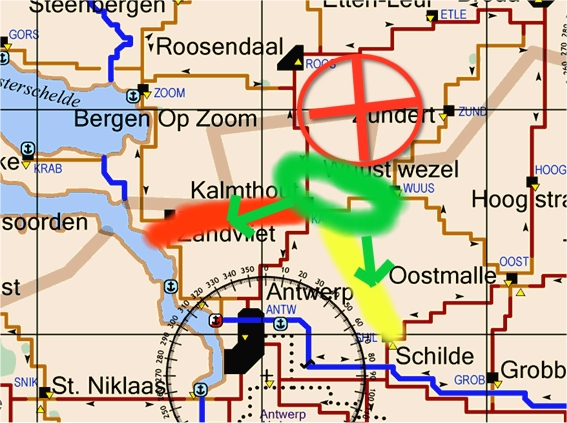
He has Red BARCAP between Kalm and Zand to keep anything
climb North out antwerp covered. He has Yellow BARCAP between Schilde &
Wuust/Kalm to keep anything climbing East or Northeast out of Antwerp
Covered. He has both of these flights ~2km, just under the 1st cloud layer
so they can spot the enemy with ease as they climb out. He has green as the
Pivot at ~4km in a holding pattern just behind where the two Barcaps meet.
Whichever flight contacts and engages the enemy... green will move to their
side in a supporting role incase they are needed. If the shit hits the fan
and EA from Brussels comes raining in with more energy to break up a
particular BARCAP, the Pivot Flight will be all over their Ass. In an effort
to keep everyone's enjoyment up.. the staffel leader should rotate the
flights between engagements. Yellow moves to red's BARCAP, Red takes Green's
position... and Green moves into Yellow's CAP.
Now say the allies are pushing on Zundert, and there is
moderate enemy air? The staffel forms at S-hertog, climbs to altitude and
heads to zundert at 5km. The initial plan is for Red to be the engaged
flight, yellow in support, and green in BARCAP. Nearing the target, the
schwarme split up and take up their assigned roles. Red dives in takes the
fight to the enemy, with yellow following them for high cover. The two of
them coordinate their schwarmes for maximum pressure.. continually swapping
schwarmes in and out of the fight so that no advantage is ever lost. Green
however continues on and sets up a BARCAP southwest of the target to keep
any more EA trying to reach the area busy. During a lull in the fight.. or
when red and yellow need to regroup and regain composure... roles can be
rotated with green flight.
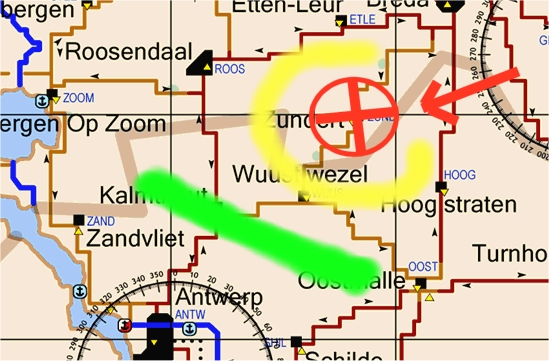
Green should really just be a harassing element. It should
not get itself engaged for too long as it is by itself... and enemy can slip
through to the target area flights. When green engages enemy.. it should
notify the other flights with "Engaged Offensive" or "Engaged Defensive". If
defensive, the target area should be forgotten about and all flights go to
green's aid. If it's an offensive call, yellow and red need to be aware that
at any moment.. green could become defensive. If they are not tied up with
combat, they should move to a support role for green. If they ARE in combat,
they need to loosen their attack in case they are needed to aid green.
Another approach to the scenario above could be a
staggered schwarme attack. Red flight dives into the enemy, mixes it up for
a few revolutions then melts away towards the barcap zone. Just before they
disengage, Yellow flight dives in to attract their attention, fights for a
few revolutions then melts away north as Green Dives in. Green resumes the
fight, while yellow sets up for the supporting role... then you continue the
operation as laid out earlier. In this case whoever is BARCAP would dive in
first, whoever is support goes in second.. and target flight third.
Or you could do a full on staffel attack. Come in from
three directions and overwhelm the enemy.. The idea is to shock the enemy
into the defensive,... then quickly melt away into your assigned tasks...
BARCAP, SUPPORT, AND TARGET. Staffel goes in, hits hard and quick.. then
melts away before it turns into chaos.
Basically there's a million ways to approach any given
situation the war presents us. The idea behind these staffel tactics is to
coordinate flights for maximum coverage to lock areas down. Flights will
operate relatively close so they can support each other when needed, or all
at once to overwhelm the enemy... but they will have their own roles to
fulfil and should avoid keeping themselves too tied up to be of support to
the other flights.
I could give allot more examples, but for now I'm
pooped.... and I think by now you get the idea...... Domination through
Teamwork.
Air Combat Manoeuvres continued Part 3
Introduction: (Author Gutter from JG52)
The Staffel......maximum pwnage. A staffel by default consists of three schwarme (2 minimum, 4 maximum) acting in concert to achieve the ultimate goal of dominance in a specified sector of the front. To achieve this feat and to avoid winding up in a careless free for all, all pilots involved really need to step it up a notch. I can't stress that enough. The more planes & pilots you add into the mix, the harder it is to coordinate and the more likely people start dying due to carelessness. In reality, it's not all that hard if everyone is working with the same game plan. In a nutshell... Everything you've read about the rotte and schwarme up to this point still applies, the difference is in the execution of everything. Comms, formations, and teamwork go to new heights when operating as a staffel... and tactics to completely shut down an area (as opposed to being a nuisance) start to become a reality.
Pre-Flight:
Staffel Lead:-
Flying as a staffel takes a bit of prep work. During the form up, flight assignments will be given out. This is handled by the ranking officer online. i.e.. If it's Gruppe I's time zone.. the Gruppe I. Commander is the head guy for this mission. If he is not present... it goes to his Adjutant, after him it's completely rank based... although anyone (including the Commander) can choose to pass it down if they don't feel like leading that sortie.
Assignment considerations:-
Flight assignments should always be given in a manner that will balance the experience throughout the staffel. i.e.. Don't put all your experienced pilots in one schwarme, and leave the others vulnerable. Put your most experienced pilots as flight leads, and then the next most experienced as section leads. Leadership abilities should also be considered when issuing lead positions. It's a balancing act. Though it must be stated, that you shouldn't always have the same guys leading day in and day out. Other pilots should have chances to gain some experience in that role as well.
Issuing Flight Assignments:-
Note: The individual schwarme of the staffel will be designated as Red, Yellow, Green, & Blue (1, 2, 3, 4) for organization & communication purposes. This becomes more important in comms (discussed later), but i state it now because its relevant.
As lead of the staffel, you should always hand out assignments in the same manner. You state the flight (Red, Yellow, Green, etc. etc.) and then the four pilots who will make up that flight. The first pilot named is the flight lead, the second pilot named is his wingman, the 3rd is the section lead, and the 4th is the section leads wingman.
Example:
"Yellow flight is Whoofe, Fish, Raus & Stalski....... Green flight is Zacast, Chief, Fridge & Hahn".
Whoofe(1) is Yellow lead with Fish(2) as his wingman. Raus(3) is lead of second Element with Stalski(4) as his wingman. The numbers i placed there correspond to the position in formation images I show later. Same applies to the Green flight. Basically just keep it consistent to make it less confusing for pilots. If we always do it the someway.. no one should ever have any problems with what role they are supposed to take up.
Flight leads are an important part of the staffel. They are the voice of reason to the pilots they are leading, and are the channel through which the stafflels tasks get carried out. They should always be focused on the bigger picture, and should rally their pilots if they start becoming over aggressive and risk compromising the integrity of their flight & the staffel as a whole. The other flights are counting on you to do your job and not put undue risk to yourself. If your flight is BARCAP'ing for the other flights.. you need to make sure you keep in a position to be effective in your role. As soon as you get too tied up, whether it be deck furballing or running down enemies.... the other flights could be in jeopardy because the BARCAP is no longer there. Just keep that in mind.. it's a team effort. And it's your job as flight lead, to make sure everything is running as it should.
Communication:
Obviously, with 3 to 4 schwarme (12 - 16 pilots) coordinating in supporting roles.... comms are going to break down when the shit hits the fan. To combat that, we are going to use some callsign codes & some advanced teamspeak channel features.
Teamspeak:-
If you haven't noticed by now... in our teamspeak sever under "Operations".. their are four rooms. Labelled with Red, Yellow, Green & Blue. This is not something i just decided to add on a whim. They've been there since the TS server went up a year and a half ago for just this purpose. If you haven't already, assign hotkeys to jump between those channels. Ctrl-Z, X, C, & V works well if you can't decide. Also, assign a hotkey to jump to the Operations main channel.
The staffel will congregate in the Operations main channel at form up for flight assignments and general mission overview. Once they have their flight assignments etc. they will jump to their designated TS channel. Communication between flights & other pilots will still be possible by a second 'global' transmit key being mapped. To do this, open up Settings->Key Settings from the TS menu. and Adding a new binding. Select the hotkey for that bind, and choose Whisper to->Channel pre-defs->Channel Family in the "action" section of that same dialog. Hotkeys for channel jumps discussed in the previous paragraph are set from this same dialog box under the "Switch To" action. Just make sure you set different hotkeys for each jump.
You should now have TWO transmit keys. A normal one.. that will allow you to transmit to pilots in the same channel as you. And a global one that will allow you to transmit to all pilots under the "Operations" channel, even if they are in a flight specific sub-channel. This global channel is for coordinating the flights and for emergency transmissions, and should be used less frequently than the regular channel transmit key to avoid interrupting people that may be talking amongst themselves in their respective channels. The Global channel can be used freely on long ingresses to target, but once near target.. comms on this channel are on a need to know basis.
*takes breath*
Transmitting:-
Since we've got pilots separated in TS, knowing who is talking and where its coming from is going to be very important. To address this, pilots will take on call signs derived from the colour code of the schwarme they are in and the position in that schwarme they are assuming. I.e. The lead of red flight is "Red 1" (or "Red Leader). The section lead of yellow flight is "Yellow 3" etc. etc.
Not only does this instantly let you know which TS channel this transmission is coming from, but it lets you know where in relation to the world around you the transmission is coming from also, and how you should react to it.
example:
Red flight sets up a patrol on the Eastern side of the target area, while Yellow flight is patrolling the Western Side. After ten minutes this call comes over the global TS channel out of nowhere:
"This is Red-Four I got EA all over me!"
Instantly these things happen:
1. The Pilot in the Red-Three position knows that his wingman (who should be close by) is in trouble and that he may be in danger himself.
2. Red-One & Two know that their second element (who shouldn't be far off) is in trouble and to start immediately looking around in their close vicinity for the threats.
3. Yellow flight is alerted to the situation and knows exactly where to start heading for support.
All this is communicated in one call, without having to remember voices.. or which voice is in which flight, or if this transmission came from your channel or the global channel... or even which position in that flight that voice is coming from. It's allot better than Stalski saying "I got EA all over me!". That would lead to confusion. Which flight is he in? Where are they operating? Who's his wingman? Do i even know what stalski's voice sounds like? OMG I NEED A HUG!!!
You get the idea. Comms are important.. we all know that. But when operating in a staffel, comms become critical.
Note: when transmitting on the global channel about being engaged or to relay your flights status to others... it's probably a good idea to use "Engaged Offensive, Engaged Defensive, or All clear" in your transmission.
Examples:
Red Lead (to global) - "Green, what's your status".
Green Lead (to global) -"Green Leader, All clear".Yellow 2 (to yellow) - "EA diving on us!!!" <- note: no callsign in the xmit..... in emergencies don't think, just talk!"
Yellow Lead (to global) - "This is yellow, Engaged defensive, NW town.... 2.5".
Blue Lead (to global) - "Copy yellow, blue is on the way".Green Lead (to global) - "This is green, Engaged offensive, S town... 4k".
Red Lead (to global) - "Copy green, Red otw for support".
Red Lead (to red) - "red 3, go element abreast".
So now you know how to organize the mission, how to break into flights, xmit across channels with clarity and ease.. etc etc. All the Basics! Let's keep moving shall we?
Formation Flying:
I won't spend much time on this, because by now you should all know the basic formations we use. If you need a refresher (recommended), see the schwarme and rotte pages. The formation of the staffel is completely up to the staffel lead (Red Leader). When forming as a staffel however, the schwarme themselves should be separate, easily discoverable parts of the formation. You don't want to be a giant mass of fighters, it makes it hard to see who is with who and completely pork's coordinated heading changes. If there's 3 schwarme flying in Line Abreast.....the 3 schwarme should EACH be in either a tight Finger Four or a tight Echelon. When you look off your wing at another schwarme in line abreast, you should see a tight formation off your wing some distance away and they should be easily distinguishable from the aircraft in your own formation. So basically what I'm saying is CLOSE THOSE FORMATIONS UP. When flying as a staffel formation.. we don't need each scharme in a loose "combat spread", they each need to be closed up so that staffel formation turns are quick and can be executed without it falling apart. Here are some examples off staffel formations:
Note: in the following pics, schwarme can be either a Finger Four or Echelon... and is specified by the flight lead. If a schwarme is isolated due to combat action... or just due to the layout of the formation type itself... it should be in it's own defensive lookout formation such as line or element abreast without regard to the rest of the staffel.

For a three schwarme staffel, my picks for most used would be the Section & Stinger, and Full line abreast. For four schwarme staffels... the staggered abreast would probably be most used. Or maybe have 3 out front in line abreast with the forth as a stinger. Note, the Circle ranges stated above are just recommendations, and are most likely going to be slightly further apart in practice to keep flights out of each others hair.
As was stated above, if a schwarme is apart from the staffel formation (due to combat or the nature of the staffel formation)... standard schwarme formation types are used for it instead of tight finger four or echelon formations. For instance, if Yellow flight splits from the staffel formation upon arrival at the objective to do its own assigned task... yellow flight breaks it's tight formation and assumes a more "combat spread" schwarme formation (see schwarme tactics). Another example would be if Green flight is assigned a high six stinger position on the formation.. it would fly in a more abreast type formation for lookout coverage.
Formation flying is half the fun of being in a squad. At least to me. When you see a good formation, it gives you goose bumps. And any enemy who stumbles into an intimidating staffel formation like the ones above... is going to shat themselves. Imagine being in a random gaggle of spitfires, and approaching from the distance is 3 tight beautiful Finger Four formations of 109's arranged in a wide line-abreast. The schwarme on the ends kick out to bracket you guys and the one in the middle menacingly drives right on in to you. Would you not totally shit yourself? You would think "Oh ... Meh ... God... These.. guys must be pro's... I gotta get the fark outta here!".
Staffel Tactics & Combat
Rotte & Schwarme tactics were mainly involved in the details of actual combat & survival. i.e.. how to execute a fight & stay alive. Staffel tactics is more of an abstraction that is laid over those two. It deals more with coordination and high-level group tactics for controlling airspace, and is the final step to the whole "Domination Through Teamwork" motto. There are no hard rules here. It is up to the Staffel leader to decide best how to use his available forces. He should survey the air situation, and devise a plan that will achieve the desired outcome.
Examples:
Say that the area of airspace contention is the zundert/roos/wuustwezel area. We want control of the airspace there. Upon arriving there, EA is extremely light. Staffel lead decides to keep enemy aircraft from ever reaching it. This would be the gameplan.

He has Red BARCAP between Kalm and Zand to keep anything climb North out antwerp covered. He has Yellow BARCAP between Schilde & Wuust/Kalm to keep anything climbing East or Northeast out of Antwerp Covered. He has both of these flights ~2km, just under the 1st cloud layer so they can spot the enemy with ease as they climb out. He has green as the Pivot at ~4km in a holding pattern just behind where the two Barcaps meet. Whichever flight contacts and engages the enemy... green will move to their side in a supporting role incase they are needed. If the shit hits the fan and EA from Brussels comes raining in with more energy to break up a particular BARCAP, the Pivot Flight will be all over their Ass. In an effort to keep everyone's enjoyment up.. the staffel leader should rotate the flights between engagements. Yellow moves to red's BARCAP, Red takes Green's position... and Green moves into Yellow's CAP.
Now say the allies are pushing on Zundert, and there is moderate enemy air? The staffel forms at S-hertog, climbs to altitude and heads to zundert at 5km. The initial plan is for Red to be the engaged flight, yellow in support, and green in BARCAP. Nearing the target, the schwarme split up and take up their assigned roles. Red dives in takes the fight to the enemy, with yellow following them for high cover. The two of them coordinate their schwarmes for maximum pressure.. continually swapping schwarmes in and out of the fight so that no advantage is ever lost. Green however continues on and sets up a BARCAP southwest of the target to keep any more EA trying to reach the area busy. During a lull in the fight.. or when red and yellow need to regroup and regain composure... roles can be rotated with green flight.

Green should really just be a harassing element. It should not get itself engaged for too long as it is by itself... and enemy can slip through to the target area flights. When green engages enemy.. it should notify the other flights with "Engaged Offensive" or "Engaged Defensive". If defensive, the target area should be forgotten about and all flights go to green's aid. If it's an offensive call, yellow and red need to be aware that at any moment.. green could become defensive. If they are not tied up with combat, they should move to a support role for green. If they ARE in combat, they need to loosen their attack in case they are needed to aid green.
Another approach to the scenario above could be a staggered schwarme attack. Red flight dives into the enemy, mixes it up for a few revolutions then melts away towards the barcap zone. Just before they disengage, Yellow flight dives in to attract their attention, fights for a few revolutions then melts away north as Green Dives in. Green resumes the fight, while yellow sets up for the supporting role... then you continue the operation as laid out earlier. In this case whoever is BARCAP would dive in first, whoever is support goes in second.. and target flight third.
Or you could do a full on staffel attack. Come in from three directions and overwhelm the enemy.. The idea is to shock the enemy into the defensive,... then quickly melt away into your assigned tasks... BARCAP, SUPPORT, AND TARGET. Staffel goes in, hits hard and quick.. then melts away before it turns into chaos.
Basically there's a million ways to approach any given situation the war presents us. The idea behind these staffel tactics is to coordinate flights for maximum coverage to lock areas down. Flights will operate relatively close so they can support each other when needed, or all at once to overwhelm the enemy... but they will have their own roles to fulfil and should avoid keeping themselves too tied up to be of support to the other flights.
I could give allot more examples, but for now I'm pooped.... and I think by now you get the idea...... Domination through Teamwork.

